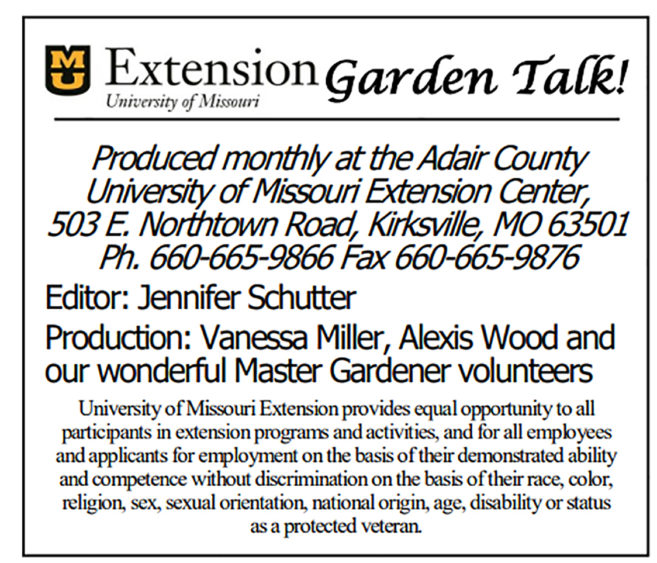
KJFM NEWS – Garden Talk is produced monthly at the Adair County University of Missouri Extension Center in Kirksville, Mo.
Fruits
Many fruits are enjoyed through the fall. Grapes, fall raspberries, pears and apples are a few that are grown by backyard gardeners and harvested and preserved for the winter months. Pick pears from trees when they are a mature size and allow to ripen indoors at room temperature. When selecting apples, keep in mind the particular attributes of the different varieties and how they suit your intended uses. Some apples are best for eating fresh while others are best for cooking. Some varieties can be used for both. In mid to late fall, pawpaw and persimmons will be ready for harvest. These fruits are ready when they are soft, but you will have to beat the wildlife to them.
Vegetables
Plant garlic now. Finish harvesting warm-season vegetables, most of which can be preserved by canning or freezing. Pumpkins can be harvested whenever they are a deep, solid color and the rind is hard. If vines remain healthy, harvest in late September or early October before a heavy frost. If vines die prematurely from disease or other causes, harvest the mature fruit and store them in a moderately warm, dry place until ready to use. Cut pumpkins from the vines using pruning shears or a sharp knife and leave 3 to 4 inches of stem attached. Pumpkins without stems usually do not keep well. Dig sweet potatoes before a frost and store in a warm, dry place. After a hard freeze clean up the garden by removing dead plants. Fall is a good time to take a soil test. Nutrients applied to the soil in the fall will have all winter to work in the ground making the soil ready for planting in the spring.
Flowers
Goldenrod, solidago sp., blooms the same time as ragweed, so a lot of people think it is the goldenrod plant that is causing their allergies, when indeed it is the ragweed. Goldenrod gets blamed because it is so visible and abundant. Ragweed is wind pollinated. Warm temperatures, lower humidity and active breezes after sunrise help create an ideal environment for ragweed flowers to release pollen into the air causing allergies for many people.
Pollen grains of goldenrod, as is true of all insect-pollinated flowers, are fairly large and sticky and will adhere to insects when they visit the flowers and then are transferred by them to another flower. A person would have to stick their nose right into a goldenrod flower in order for them to be affected by goldenrod pollen. Fall is a good time to divide perennials, particularly those that bloom in the spring such as peonies. Dig the plants on a cool, cloudy day. Make sure each section you divide has at least one bud and some roots. Make sure the plant to be divided is suitable for fall division before digging. A general rule of thumb is if the plant blooms in the spring, divide them in the fall. If they bloom in late summer or fall, division is best done in the spring.
Lawns
Ideally there are two times during the year when lawns should be seeded, early spring, typically by mid-April and again in September/October, in north Missouri. Often you will get better establishment if you wait until September to reseed a cool-season lawn. The soil is still warm, but the air temperature is lower, therefore there is less evaporation of moisture needed by the young grass seedlings. A turf-type tall fescue blend is recommended. This is a blend of different fescue cultivars and it can be purchased at most garden centers and farm supply stores. Establishing a lawn in shady areas can be a challenge. Prune off lower limbs of trees to allow more sunlight to the area and use shade tolerant tall fescue when reseeding. Fertilize cool-season lawns now at a rate of one pound of nitrogen per 1000 square feet.
Insects
It is the time of year when the Asian lady beetles make their appearance in homes. As winter approaches the adults seek out protection and cluster in warm locations to hibernate. The beetles enter homes through window screens, doors, cracks in the walls or vents. It is important to try to prevent the beetles from getting into the home by sealing outside cracks around doors, windows and siding. Window screens should fit snugly and not have any tears or holes and screening should be installed over attic and exhaust vents. A common web-producing insect found in Missouri at this time is the fall webworm. It is a serious pest of many species of forest, shade, fruit, and ornamental trees found throughout the United States and southern Canada. Webs are made on the outer periphery of the tree. Prune off and destroy the infested leaves or twigs or tear webs open to allow the larvae to fall to the ground and be eaten by predators, particularly birds.
